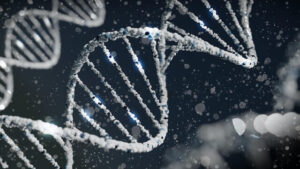
Table of Contents
Autism, or Autism Spectrum Disorder (ASD), is a complex developmental condition that involves persistent challenges in social skills, speech and nonverbal communication, and restricted/repetitive behaviors. The effects of ASD and its severity can vary widely among individuals affected by the condition. But how is autism developed? In this post, we’ll delve into what science tells us about the development of autism spectrum disorder in children.
Risk Factors
The Role of Genetics
Extensive research indicates that autism spectrum disorder has a strong genetic basis. According to the National Institute of Mental Health, heritability contributes to about 83% of the risk of a child developing autism. This means that genetics play a significant role in the likelihood of a child being diagnosed with ASD.
However, it’s important to note that there isn’t a single “autism gene.” Instead, many different genetic factors appear to be involved. Some may make a child more susceptible to the disorder, others may affect brain development or the way that brain cells communicate, or they may determine the severity of symptoms. Some genetic problems seem to be inherited, while others occur spontaneously.
Environmental Factors
While genetics play a key role, they aren’t the whole story. Environmental influences also contribute to the autism risk, although researchers are still working to understand how and to what extent these influences might cause ASD.
Certain circumstances during pregnancy have been linked to an increased risk of autism. For example, children born to older parents, complications during pregnancy or delivery like very low birth weight and preterm birth, and pregnancies spaced less than one year apart are all factors that have been associated with an increased risk of autism.
The Interplay of Genetic and Environmental Factors
The current understanding among scientists is that a person’s genes and their environment interact to determine whether they develop autism. This is known as the “gene-environment interaction.”
For example, having a specific genetic mutation might make a person more susceptible to a particular environmental trigger, resulting in autism. Alternatively, exposure to certain environmental factors could cause changes in the genes, leading to the development of ASD.
Early Signs and Diagnosis
There is no medical test, like a blood test, to diagnose the disorders. Doctors look at the child’s behavior and development to make a diagnosis. ASD can sometimes be detected at 18 months or younger, but by age 2, a diagnosis by an experienced professional can be considered very reliable. The American Academy of Pediatrics recommends that all children be screened for autism spectrum disorder at their 18- and 24-month well-child checkups.
Early Signs of Autism
Children with autism exhibit a broad range of symptoms, which can vary in severity. Here are some potential early signs of autism in children:
- Social Communication and Interaction: Children with autism may struggle with reciprocal social interactions. This might be noticeable as a lack of eye contact, diminished facial expressions, or difficulties understanding nonverbal cues. They may also exhibit a limited interest in peers and might struggle with sharing emotions or understanding the feelings of others.
- Speech and Language: Speech delay is often one of the most obvious signs of autism. Some children may not speak at all, while others might repeat phrases or sentences verbatim (known as echolalia) without understanding their meaning.
- Repetitive and Restricted Behaviors: Children with autism often engage in repetitive behaviors or have unusually intense interests. This can include lining up toys, obsessively following routines, or being extremely distressed by minor changes in their environment.
- Sensory Sensitivities: Many children with autism are either over-responsive or under-responsive to sensory input. They might react excessively to certain sounds, textures, or lights. Conversely, they might show a lack of responsiveness to others.
If you notice any of these signs or have concerns about your child’s development, consult with a healthcare provider. Early intervention can make a significant difference in the lives of children with autism.
Conclusion
Autism spectrum disorder is a complex disorder that is likely caused by a combination of genetic and environmental factors. While we don’t yet fully understand the causes of autism, ongoing research continues to provide valuable insights. Recognizing the early signs and getting early intervention can significantly improve a child’s development.
Remember, every child with autism is unique. With support and treatment, they can all learn and thrive. The most important thing is to find resources and treatments that work best for each individual.
If you are ready to work with the best ABA therapy provider in New York, New Jersey or Indiana, give us a call at (732) 402-0297. Our dedicated team is ready to help and we will treat you like family.
- Autism Routine Disruption in Adults: Coping Tips - July 16, 2024
- Autism and Obsession: An Overview - July 16, 2024
- Autism and Taking Clothes Off: Management Tips - July 16, 2024



